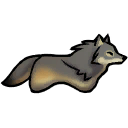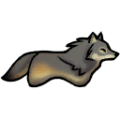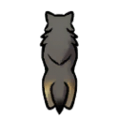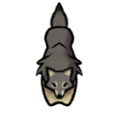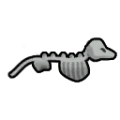Difference between revisions of "Timber wolf"
| Line 67: | Line 67: | ||
== Analysis == | == Analysis == | ||
Timber wolves can make for good hauling animals and decent attack animals, if you can keep them fed. While they are more wild than a [[husky]], meaning they create more [[filth]] and need to be retrained, timber wolves will not be attacked by other predators. You can feed them off meals, and wolves are actually more efficient than huskies when it comes for hunger rate. However, you'll need raw meat or [[kibble]] to train them. | Timber wolves can make for good hauling animals and decent attack animals, if you can keep them fed. While they are more wild than a [[husky]], meaning they create more [[filth]] and need to be retrained, timber wolves will not be attacked by other predators. You can feed them off meals, and wolves are actually more efficient than huskies when it comes for hunger rate. However, you'll need raw meat or [[kibble]] to train them. | ||
| + | |||
| + | [[Cougar]]s and [[panther]]s are easier to tame, need to be retrained less often, and carry more in a single stride (at the same movement speed). They are also stronger in combat, all at the cost of {{%|{{Q|Panther|Base Hunger Rate}} / {{P|Base Hunger Rate}} -1 round 2}} more hunger. However, these cats tend to spawn in warm biomes, while wolves spawn in cold ones. | ||
== Training == | == Training == | ||
Revision as of 18:17, 17 March 2023
Timber wolf
A rugged predator long feared by many ancient Earth cultures. As pack hunters, wolves have complex social lives and are fiercely intelligent.
Base Stats
- Type
- Animal
- Flammability
- 70%
Pawn Stats
- Move Speed
- 5 c/s
- Health Scale
- 99% HP
- Body Size
- 0.85
- Mass - Baby
- 10.2 kg
- Mass - Juvenile
- 25.5 kg
- Mass - Adult
- 51 kg
- Carrying Capacity
- 64 kg
- Filth Rate
- 2
- Hunger Rate
- 0.29 Nutrition/Day
- Diet
- carnivorous
- Life Expectancy
- 12 years
- Manhunter Chance
- 100%
- Manhunter Chance (Taming)
- 30%
- Trainable Intelligence
- Advanced
- Wildness
- 85%
- Minimum Handling Skill
- 8
- Mate Interval
- 12 hours
- Maturity Age
- 0.5 years (30 days)
- Juvenile Age
- 0.2 years (12 days)
- Comfortable Temp Range
- -40 °C – 40 °C (-40 °F – 104 °F)
Production
- Meat Yield
- 119
 wolf meat
wolf meat - Leather Yield
- 36
 wolfskin
wolfskin - Gestation Period
- 10 days
- Offspring Per Birth
- 1-3 (1.721 avg)
Melee Combat
- Attack 1
- Front left paw
10.9 dmg (Scratch)
16 % AP
2 second cooldown
0.5 chance factor
Stun for 280 ticks (4.67 secs) on first strike - Attack 2
- Front right paw
10.9 dmg (Scratch)
16 % AP
2 second cooldown
0.5 chance factor
Stun for 280 ticks (4.67 secs) on first strike - Attack 3
- Teeth
12 dmg (Bite)
18 % AP
2 second cooldown
0.9 chance factor
Stun for 280 ticks (4.67 secs) on first strike - Attack 4
- Head
6 dmg (Blunt)
9 % AP
2 second cooldown
0.2 chance factor - Average DPS
- 3.08
- tradeTags
- AnimalUncommon, AnimalFighter
The timber wolf is a pack hunter but often seen alone or in pairs. They are almost identical to arctic wolves, differing only in habitat, resistance to cold temperatures and coloration. Timber wolves can be found in temperate forests, temperate swamps, boreal forests, cold bogs, and tundra.
Diet
Timber wolves feed on raw meat, corpses, meals, any processed foods, and kibble. When especially hungry, they will frequently attempt to attack, kill, and eat pets or even colonists for food.
Analysis
Timber wolves can make for good hauling animals and decent attack animals, if you can keep them fed. While they are more wild than a husky, meaning they create more filth and need to be retrained, timber wolves will not be attacked by other predators. You can feed them off meals, and wolves are actually more efficient than huskies when it comes for hunger rate. However, you'll need raw meat or kibble to train them.
Cougars and panthers are easier to tame, need to be retrained less often, and carry more in a single stride (at the same movement speed). They are also stronger in combat, all at the cost of 11% more hunger. However, these cats tend to spawn in warm biomes, while wolves spawn in cold ones.
Training
This animal can be trained as follows:
| Guard: | |
|---|---|
| Attack: | |
| Rescue: | |
| Haul: | |
*As of version 1.1.2610, all animals can be tamed. The percentage of likelihood of success depends on factors such as the Animals Wildness Percentage, Pawn Handling Skill, and others. More information can be found on the animals page.
Health
Gallery
Version history
- Beta 19/1.0 - Trainable intelligence Advanced -> Intermediate, bite damage 11 -> 12, scratch usage commonality 100% -> 50% per side, nuzzle interval 120 -> 240 hours
